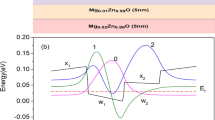Abstract
The conduction band states in step-like strained zincblende nitride-based quantum wells are theoretically investigated including effects of band non-parabolicity. In particular, the intersubband Raman gain is calculated in order to identify the possible use of this kind of structures as sources of THz Raman lasing. The theoretical procedure includes the use of the envelope function approximation, taking into account strain effects on the conduction band offset and position-dependent non-parabolic effective masses. Three-level Raman gain is reported for a group of possible intersubband transitions. The results are discussed in terms of the variation of the geometry of the heterostructure as well as the concentration of In in the well regions. It is shown that under a suitable geometric design and plausible detuning conditions it is possible to achieve–for certain intersubband transitions–values of the intersubband Raman gain above \(1000\,\hbox {cm}^{-1}\), quite larger than those previously reported in GaAs- and wurtzite GaN-based double asymmetric quantum wells. Besides, it is found that the band-nonparabolicity acts as a significant element that reduces the Raman gain response in this kind of systems, whereas strain affects it in the same way but the changes are mainly noticed for higher In contents. It turns out that it is necessary to take both effects into account for the better quantitative description on intersubband Raman response in zincblende nitride heterostructures.







Similar content being viewed by others
References
As, D.J., Mietze, C.: MBE growth and applications of cubic AlN/GaN quantum wells. Phys. Stat. Sol. A 210, 474–479 (2013)
Biswas, S., Islam, Md. S., Mahbub, I., Adnan, F.: Numerical investigation of the effects of conduction band nonparabolicity on the conduction sub-band dispersion relationships in a \(Al_{0.88}In_{0.12}N/Ga_{0.9}\). In: Lecture Notes on Photonics and Optoelectronics, Vol. 1, pp. 1–5 (2013). https://doi.org/10.12720/lnpo.1.1.1-5
Biswas, S., Mahbub, I., Islam, Md. S.: Conduction band-valence band coupling effects on the band structure of \(In_{0.28}Ga_{0.72}N/GaN\) quantum well. In: 2013 Spanish Conference on Electron Devices (CDE), pp. 211–214 (2013)
El Ghazi, H., Peter, A.J.: Impurity-related nonlinear optical absorption under combined effects of intense laser field and band-edge nonparabolicity on InGaN QW. Int. J. Modern Phys. B 29, 1550110 (2015). https://doi.org/10.1142/S0217979215501106
Li, J.M., Lu, Y.W., Han, X.X., Wu, J.J., Liu, X.L., Zhu, Q.S., Wang, Z.G.: Theoretical investigation of intersubband transition in \({Al}_x{Ga}_{1x}N/GaN/Al_y Ga_{1y}N\) step quantum well. Physica E 28, 453–461 (2005)
Mourad, D.: Tight-binding branch-point energies and band offsets for cubic InN, GaN, AlN, and AlGaN alloys. J. Appl. Phys. 113, 123705 (2013). https://doi.org/10.1063/1.4796093
Muellhaeuser, J. R., Klann, R., Yang, H., Brandt, O., Ploog, K. H.: Are cubic nitrides viable materials for optoelectronic devices? In: Proceedings of the SPIE 3279, Light-Emitting Diodes: Research, Manufacturing, and Applications II (1998). https://doi.org/10.1117/12.304428
Plessey to fabricate LEDs in cubic GaN on Anvil’s 3C-SiC/Si substrates to overcome “green gap” in efficiency, in News section of Semiconductor Today. Compd. Adv. Silicon 11(1), 46 (2016)
Radosavljević, A., Radovanović, J., Milanović, V., Indjin, D.: Cubic GaN/AlGaN based quantum wells optimized for applications to tunable mid-infrared photodetectors. Opt. Quant. Electron. 47, 865–872 (2015)
Rosencher, E., Bois, P.: Model system for optical nonlinearities: asymmetric quantum wells. Phys. Rev. B 44, 11315–11327 (1991)
Rosencher, E., Bois, P., Nagle, J., Delaitre, S.: Second harmonic generation by intersubband transitions in compositionally asymmetrical MQWs. Electron. Lett. 25, 1063–1065 (1989)
Sirtori, C., Capasso, F., Faist, J., Scandolo, S.: Nonparabolicity and a sum rule associated with bound-to-bound and bound-to-continuum intersubband transitions in quantum wells. Phys. Rev. B 50, 8663–8674 (1994)
Solaimani, M., Aleomraninejad, S.M.A., Lavaei, L.: Optical rectication in quantum wells within different connement and nonlinearity regimes. Superlattice Microstruct. 111, 556–567 (2017)
Sun, G., Khurgin, J.B., Friedman, L., Soref, R.A.: Tunable intersubband Raman laser in GaAs/AlGaAs multiple quantum wells. J. Opt. Soc. Am. B 15, 648–651 (1998)
Sun, G., Khurgin, J.B., Soref, R.A.: Design of a GaN/AlGaN intersubband Raman laser electrically tunable over the \(3\,-\,5\;\mu m\) atmospheric transmission window. J. Appl. Phys. 99, 033103 (2006). https://doi.org/10.1063/1.2169349
Tsai, M.-C., Yen, S.-H., Kuo, Y.-K.: Investigation of blue InGaN light-emitting diodes with step-like quantum well. Appl. Phys. A 104, 621–626 (2011)
Tsujino, S.: Optical gain of two-dimensional hole gas by intersubband Raman transitions. J. Appl. Phys. 112, 023508 (2012). https://doi.org/10.1063/1.4737575
Van de Walle, C.G.: Band lineups and deformation potentials in the model-solid theory. Phys. Rev. B 39, 1871–1883 (1989)
Ziade, P., Palermo, C., Khoury, A., Habchi, R., Rahal, M., Varani, L.: Comparative analysis of nitrides band structures calculated by the empirical pseudopotential method. Univ. J. Mater. Sci. 2, 58–72 (2014)
Acknowledgements
A.T. acknowledges support from Mexican PRODEP through a postdoctoral Grant 2016–2017. This research was partially supported by Colombian Agencies: CODI-Universidad de Antioquia (Estrategia de Sostenibilidad de la Universidad de Antioquia) and Facultad de Ciencias Exactas y Naturales-Universidad de Antioquia (CAD exclusive dedication Project 2017–2018).
Author information
Authors and Affiliations
Corresponding author
Electronic supplementary material
Below is the link to the electronic supplementary material.
Rights and permissions
About this article
Cite this article
Tiutiunnyk, A., Duque, C.A. & Mora-Ramos, M.E. Intersubband Raman gain in strained zincblende III-nitride-based step asymmetric quantum wells: non-parabolicity effects. Opt Quant Electron 50, 234 (2018). https://doi.org/10.1007/s11082-018-1504-2
Received:
Accepted:
Published:
DOI: https://doi.org/10.1007/s11082-018-1504-2




